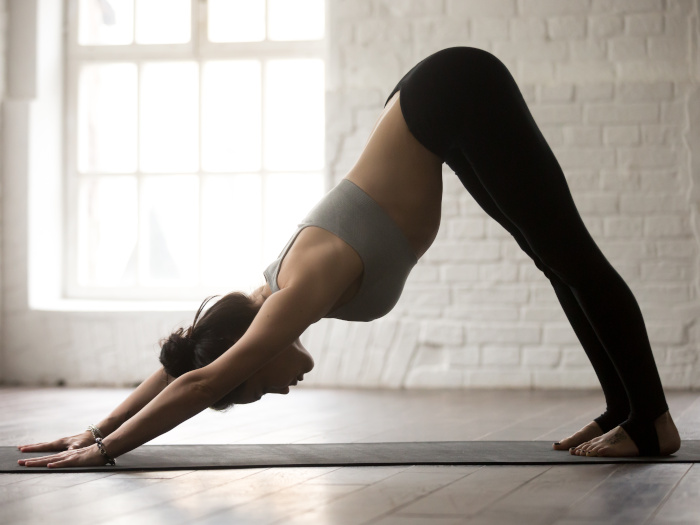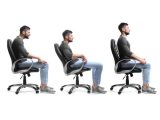Life can get busy at times, and while we all know that exercise is good for us, it does become impossible to sign up for a gym or a fitness class when work or family schedules take over. To make it easier, you can instead work out at your home at the time most suitable for you. The American Council on Exercise recommends body strength exercises that can be done by beginners, even at home for overall strength conditioning. These home workout exercises can be done together or they can be broken up in sets in different pockets of time if that is more convenient to you. So, let’s dive right in. [1]
Home Workout: Top Exercises For Beginners
To get the most out of your home workout, we have listed a mix of the upper body, lower body, and overall strengthening exercises. These include body strength exercises such as push-ups, squats, jumping jacks, calf raises, hip adductor exercises, and yoga asanas. Let us look at the step-by-step method of performing these exercises.

The downward-facing dog is an excellent pose to lengthen your spine. Photo Credit: Shutterstock
Downward Facing Dog
The downward-facing dog pose is a common asana in Yoga and is part of the Sun Salutation sequence. It helps strengthen the arms, legs, and back while stretching the hamstrings and calves.
- In the starting position, come out to the floor with your hand and knees on the floor.
- Make sure your wrists are underneath your shoulders and your knees are underneath your hips.
- Push through your hands to lift up your hips and straighten your legs.
- At first, keep your knees slightly bent and your heels away from the floor to avoid pushing pressure on your back.
- Gently lengthen your spine and slowly try to reach your heels to the floor.
- If your calves are tight, let your knees remain bent.
- Stay in this pose for 30 seconds while breathing normally.
- Return to starting position.
Forward Lunge
Lunges are excellent at-home exercises for beginners. They are a great way to build lower body strength while engaging your core muscles.
- Stand with your feet hip-width apart, with your hands resting on your hips.
- Take a lunge forward with your right leg, making sure your heels hit the ground first.
- Lower your body so that your calf is vertical and your right thigh is parallel to the ground.
- Make sure your right knee does not go past your toes.
- Press back on your right heel to return to the starting position.
- Repeat on the other side.
Calf Raises
Calf raises are a great way to strengthen your calf muscles and build stamina. Be sure to work in calf raises as part of your home workout plan.
- Stand on the edge of a step or a stair of any kind, but make sure it is stable and safe.
- Make sure the balls of your feet are firmly on the ground. Your heels should be over the edge.
- Push against the balls of your feet to push yourself up straight.
- Let your arms hang loose against the sides of your body.
- Lower to starting position. Do 10 repetitions to complete a set.
Modified Push-ups
It is best to start with a modified push-up if you have never done before or if you are starting on an exercise regime after a long break.
- Begin in a kneeling position on a yoga mat.
- Make sure your palms are a little more than shoulder-width apart and knees are behind the hips.
- Tightening the abs, bend your elbows to lower your chest to the floor.
- Keep your neck in a neutral position.
- Lift yourself to starting position, without locking your elbows.
- This completes one modified push-up.
Push-ups
Push-ups are a powerful all-body exercise that engages all the important muscles of the body. They help build endurance in the chest, arms, and leg muscles while working on stabilizing the core.
- In the starting position, keep your palms (shoulder-width apart) and knees (hips-width apart) on the floor.
- Now, extend your legs straight, balancing on your toes.
- Make sure your hands are directly under your shoulders and your elbows are not locked.
- Engaging all your muscles, keep your neck in neutral alignment so that your body is in a straight line.
- Now, bend your elbows allowing it to naturally open out on the side as your lower yourself.
- You can try to get your nose close to the floor while keeping your torso as straight as possible.
- Push into the floor to get back to the starting position.
- This is one push-up. You can begin with sets of 3 reps.
Jumping Jacks
Jumping jacks are a wonderful cardiovascular exercise that can be done at home or in an outdoor park.
- Stand upright, with your arms by your side.
- Bend your knees slightly and jump into the air.
- As you jump, spread your legs and your arms outward.
- Come back to the starting position.
Squats
Research published in the Strength and Conditioning Journal suggests that squats when performed correctly, can be a deterrent to knee injuries. Squats help build power in the lower body muscles and is considered as an essential exercise to enhance sports performance. [2]
- Stand with your feet slightly wider than your hips, with toes pointing slightly outward.
- Look straight ahead and stretch your arms in front of you, keeping it parallel to the ground.
- Maintain a neutral position in your spine.
- Keeping your weight on the heels and balls of your feet, lower yourself by bending your knees.
- Push your bottom back and keep sending your hips backward.
- Keep your knees in line with your feet. Push them outward but not wider than your feet.
- Squat till your hip joint is lower than your knees.
- To lift yourself to starting position, push on the heels and balls of your feet, and engage your core and thigh muscles.
- Come back to the starting position.
Supine Pelvic Tilts
Pelvic tilts help strengthen and stretch your erector spinor (low back) muscles and abdominal muscles.
- Lie on your back with your knees bent and your arms stretched out.
- Exhale and gently contract your abdominal muscles, without lifting your tailbone off the floor.
- Your lower back should be flattened against the floor or yoga mat. Hold the position for a count of 3.
- Inhale and lift your low back muscles in an arch while relaxing your abdominals.
- Do not raise your hips from the floor.
Lateral Leg Raises
Leg raises are a safe and simple way of exercising all the large and small muscles in the legs. This exercise also helps stabilize the hip muscles.
- Lie on your side with your legs extended. Prop yourself on the lower arm while resting the other arm in front of you.
- Lift the top leg to a 45-degree angle and lower it slowly.
- You can 10 reps to complete a set.
- To work different muscles, you can flex the toes for 5 lifts and point the toes for another 5.
Side Hip Adduction
Adductions are a great way to open up the hip muscles, which can get stiff easily. This helps in reducing the likelihood of knee or back pain.
- Lie on your side with your legs extended.
- Rest your head on the lower arm.
- Place your top leg at a right angle so that the knee is in line with the hip joint and the foot is on the floor.
- Engaging your core muscles, lift the lower leg as high as you can without rocking your body.
- Slowly lower the leg to the floor, without touching it.
- Complete 10 reps to finish a set.
While these are simple home workout exercises, you can begin with small sets of 5-10 repetitions each and work yourself up to more sets to build stamina and strength. According to Harvard Health, if you are doing 30 minutes of aerobic exercise a day and 2 days of strength exercises, you can be called an “active” person. The aerobic exercise can also be walking, ballroom dancing, playing with your kids in the park, or gardening. [3]
Word of Caution: Always check with your doctor before starting a home workout exercise plan. If you have a pre-existing health condition or musculoskeletal problems, it is best to seek expert guidance on form and techniques as well as medical advice for attempting these exercises.

